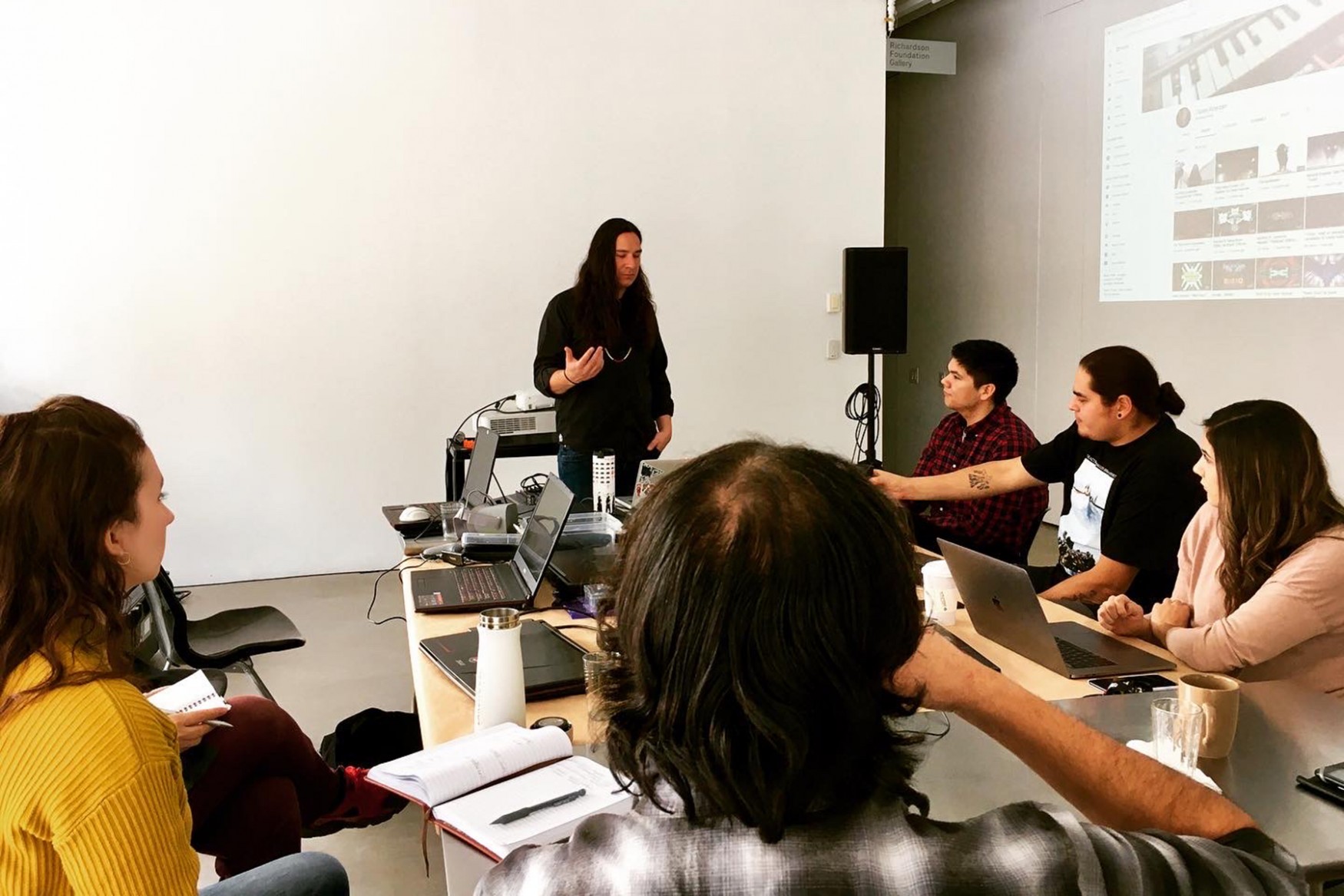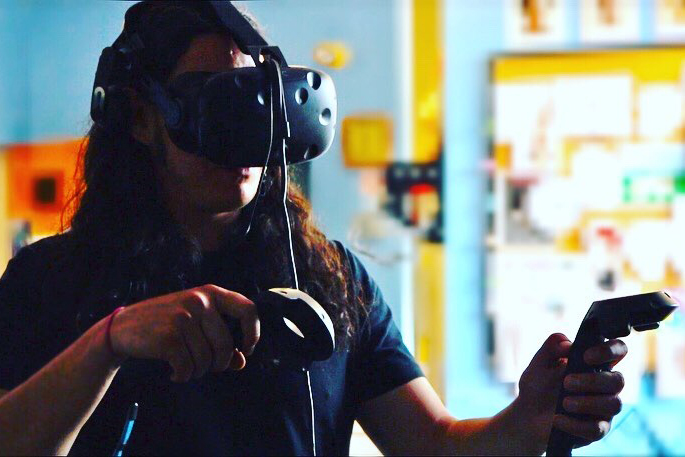Photo contributed by Casey Koyczan.
Casey Koyczan’s work has been shown across Canada and internationally, featured in films, and has even appeared in an award-winning video game. He calls Canada’s North home and is heavily influenced by the area’s people and natural features, but it wasn’t until his second year of TRU’s Bachelor of Fine Arts (BFA) program that he discovered the opportunities in sculpture and large-scale installations.
As an interdisciplinary artist, Koyczan has embraced several artistic mediums, including installation, sculpture, virtual reality (VR), video and performance art. He is now well on his way to becoming a Canadian household name, with major media outlets like the CBC profiling his evocative installation projects.
Knowing first-hand the challenges northern artists face—from geographic isolation to limited gallery and studio facilities—he’s also an ardent arts advocate for future generations in the Northwest Territories (NWT) and throughout Canada, hosting workshops and helping others to broaden their reach. He says northern artists become very resourceful, adaptable and creative in their approach to making and showing their art, and the community of artists feels more familiar than in larger centres.
“We seem to support and help each other with our projects. Everyone seems to know each other, and we house a very humble mentality when it comes to presenting our artwork,” said Koyczan.
His schedule this past summer offers a glimpse into the busy life of a full-time interdisciplinary artist. Starting in late May, Koyczan travelled to Montreal to work on a VR project with sound designer and musician Travis Mercredi. In July, he set up an installation for the Penticton Art Gallery before embarking on an artist residency in the remote and famously-creative community of Wells, BC. From Wells, he travelled to eastern Ontario to host VR and 360° art youth workshops with filmmaker Mason Mantla.

Koyczan delivering an artist talk to a small group at Winnipeg’s Plug In Institute of Contemporary Art.
Photo contributed by Casey Koyczan.
Charting a path to self-expression
Koyczan began his fine arts education at TRU, where he was drawn to small class sizes and a modestly-sized city with a down-to-earth vibe, and was pleasantly surprised by what he found.
“I was impressed with the size of the drawing, painting, sculpture and ceramics studios, as it felt like there was so much room to breathe and for creativity to flow,” he said.
He enrolled with the goal of becoming a master illustrator and painter, but when his second-year 3D Foundations course offered an opportunity to work with clay, he found he was better suited to working with his hands than with tools. Turning his focus toward sculpture, specifically installations, he discovered endless opportunities to present his visions through different materials and mediums to bring his large-scale ideas to life.
“I made my first installation within Doug Buis’ sculpture class, where I utilized willows and vines to create ‘Snow Nests’ within a site-specific location near the university,” recalls Koyczan. “The hammock-like nests held snow that melted away in the spring heat, dripping downward in the shape of a triangle to the exposed earth below. Doug’s reaction within the critique was, ‘I have nothing negative to say about this’, and at that point I knew I was on the right track with my approach to art.”
The opportunity to bring organic materials indoors to accomplish his now-signature aesthetic—nature reclaiming architectural space, as illustrated in his Natur(al) Echoes installation—came with an assemblage assignment posed by faculty member Alan Brandoli. Koyczan interwove 14 square-feet of branches, wood, headphones and microphones to create a grid depicting a city structure and marking the locations its materials were found. The piece featured an audio component that has become a fixture of his work—in this piece sound was collected through the microphones, passed through delay and distortion pedals, and played back to create a multi-sense experience.
Audio accoutrements
In addition to producing tracks to accompany his installations, Koyczan has also worked with other creators on original soundtracks and scores for short films and video games. His audio work has been showcased in Toronto’s Prefix Gallery and featured in the award-winning and controversial video game Thunderbird Strike, where he composed the music, effects and narration. The experience also gave him an opportunity to try his hand at voice acting, something he’d wanted to do since childhood.
“This is something that I absolutely love to do, and find I have the ability to ‘feel’ the visuals in order to pair them with audio that helps to support the emotion and communicate what the film or media is trying to say,” he said.
Performance art, too
Koyczan’s work also includes an element of performance art, where he embraces collaborations and utilizes technology to build on his understanding of his Tłı̨chǫ culture. As a musician, he presents as one of his personas known as NÀHGĄ, or The Bushman, which he said is known in the NWT as the “spirit of the woods.” Influenced by the animals, culture, land and people of the North, he dresses in black with hints of red and adorns a beaded eye-cover made by NWT artist Gerri Sharpe.
He strives to bridge the gap between visual and audio interpretations of art, a concept perhaps best exemplified by his 2019 Fish Eyes imagineNATIVE composition. Attendees of this annual festival viewed the video component of his act through a VR headset, while Koyczan performed the song atop a stage that will double as a multi-use shelter for local hunting, fishing and berry-picking at Behchokǫ̀’s Russell Lake. The audio was played through multiple speakers hung from trees surrounding the area to create an experience influenced by the landscape.
Telling traditional stories through virtual reality

Koyczan working in virtual reality.
Photo contributed by Casey Koyczan.
Koyczan works with virtual reality to create immersive, dream-like experiences that push the scale of arctic animals and creatures present in many of the myths, stories and visions passed down through generations of Elders.
He has recently relocated to Winnipeg to further hone his craft through a Master of Fine Arts at the University of Manitoba, where he intends to combine his installation work with new technology, and the virtual reality projects he’s been pioneering. Through future projects, he hopes to make more of an impact by incorporating environmentalism and Indigenous knowledge and teachings.
“I love working on a variety of artworks and feel that is what I’m meant to do, and this is where I’m meant to be doing it. Given the resources that I have access to [at the University of Manitoba], I plan to focus a lot more on my large-scale installation art as this is the first time since my BFA at TRU that I’ve had the time and space to be able to create my ideas in such a way.”
Advice for students: work hard and be yourself
Time management is key for an artist and Koyczan believes it’s important to keep a level head under pressure, in order to maintain positive relationships and the quality of your work. He also stresses the importance of honesty and authenticity for students hoping to build art careers:
“Stay true to yourself and your craft, treat everyone with the same amount of respect, and try to remove any sort of entitlement or self-importance from your soul so that people will always see the real you, because it is always translated through your art in some way.”
He doesn’t adhere to the popular doctrine that success in the art world is based on connections, but says that hard work, perseverance, integrity and thought-provoking ideas speak for themselves. He believes it is a privilege to create and inspire, and reinforces this with something he’s shared with first and second year BFA students in his role as teachers assistant in Winnipeg:
“We are the weirdos, we are the outcasts, we are the people that come from broken homes. We are the ones that look at the world in a different way and choose to express that creatively. We are the artists.” – Casey Koyczan
Follow Koyczan’s work online and on social media:
- Web: caseykoyczan.com / nahgamusic.com
- Instagram: @caseykoyczanart / @nahgamusic
- Facebook: @caseykoyczanart / @nahgamusic

